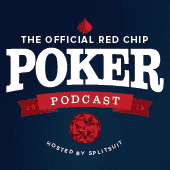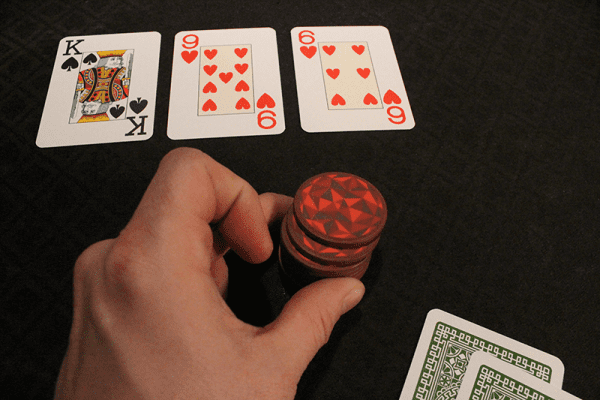This episode jumps right into the action with Doug Hull and Ed Miller chairing our 25th episode. The topic of the week is streets of value and how to use this concept to better plan your actions in every hand. It’s inspired by Miller’s book The Course (and the companion video series, available to Red Chip Poker PRO members). In The Course, the idea of “streets of value” is central to developing the skills that will take you from $1/$2 to $5/$10.

Get Streetwise
Miller explains the “streets of value” as asking the following question:
How many times can I bet this hand and get called, and still feel like I’m ahead?”
That single question packs more strategic punch than any concept you can bring to the table, and that’s why it’s Miller’s Skill #3 in The Course — an absolute fundamental.
Another way of looking at it would be as a litmus test for whether or not you are betting for value. It’s a value bet if you’re going to win half the time, roughly speaking. But we have three post-flop bet/call opportunities in NLHE.
An easy example: Let’s say you bet the flop and get called, bet the turn and get called, then bet the river and get called. If your hand figures to be the favorite at over half of all showdowns, you hand had three streets of value. If it’s a loser more than 50% of the time, the three streets of value are one-way streets headed away from your chipstack.
In the example above, a hand that has three streets of value is typically a very strong hand, if not the nuts. An exception might be a table full of crazy maniacs. But for the hand to have had three streets of value, starting with the flop, we’re talking about flopping a set, a nut straight or flush — a monster. Most hands are not that strong.
Hull points out a quip from the forums: A good value bet is not a bet that you get value out of more than 50% of the time, a good value bet is one you get value out of more than 50% of the time you bet and are called. You must factor in the strength of the other opponent’s hand on each street to understand if you’re betting for value.
If you have a value hand, your goal should be to get the hand to showdown, and to bet it as many times as you can, and still be getting value.
A Hand Example
Hull brings up a hand involving Hero making a lite raise the button with A5 vs. a single limper and gets called. Hero flops A67 (6 & 7 are suited) and Hull points out this is a middle-strength hand and wonders how many streets of value one could get from it.
To calculate streets of value, Ed answers with a question: “Can you bet the flop and get called by worse hands?”
On this flop, this answer would be yes. Straight draws and flush draws are calling. Being called by a weaker ace is interesting to contemplate, because by the time the river arrives, your kicker is not likely to play, and a lower one would just chop. Maybe you’d be called by pocket kings through eights. You might even be called by a weak pair-draw combo like 97. The number of worse hands calling are likely to outnumber the number of better hands calling here, so one street of value looks likely.
But what about two streets?
Miller imagines a 9 hitting the flop. Here, can you bet and still get called by worse hands? Well, again, there aren’t really any worse aces because of the kicker situation that are going to be calling you. Of course it’s player dependent, but for most here, pocket kings through eights is not very likely to continue vs. two barrels. The draws, if they keep chasing, are not that far behind you on the turn.
Making matters worse, many $1/$2 players are limp-calling here with hands like AQ, AJ, AT, A9, A8 and A7, all hands that have you crushed. The passive calling-down is also typical of the type of player found at this level.
It’s pretty clear from this analysis that the A5 on this flop is looking at just one street of value. If you get your bet called on the turn, it’s bad news, and probably a bad move.
To wrap the analysis, Miller notes that if you were to go for three streets of value here and get called, he would expect you to be dead at showdown.
With this type of planning ahead, hands that were once tricky for you to play will become a lot more straightforward.
Factoring Flop Texture

It may have already occurred to you that flop texture is central to the “streets of value” calculation. In the previous example, the first street of value largely depended on expecting draws to call a bet. Miller talks about the flop check as a viable move, if only to get the information on whether or not you’re behind. Letting it go check-check on the flop is not the end of the world when streets of value are difficult to discern by just looking at board texture and player tendencies.
Checking the flop is not just about getting information, though. Yes, typically when we have one street of value we are talking about betting the flop. But Miller points out, if you have one street of value, there is nothing stopping you here from collecting it on the turn instead of the flop (unless you face lots of opponent aggression, in which case you likely made the right choice to check). Especially against certain player types, Miller recommends checking the flop and betting the turn to get that street of value you’re after.
But wait, Hull takes the idea one step further and actually suggests there are two streets of value in the A5 hand. Hull has noticed in his grind that if top pair checks through, players with second or sometimes even third pair think they are good. He proposes checking flop, and betting turn and river to get value from a worse pair that reads the flop check as weakness, not trapping. Again, this is dependent on position and player type, but it goes to show how “streets of value” is a malleable concept. Miller concurs there is “deception value” in this play.
Poker’s 1%
Ed Miller’s book Poker’s 1% also factors into the discussion. In that book, Miller discusses how the top players use game theory optimal play to balance their ranges and be very unpredictable to other high-level players. While he thinks it’s an important theory consideration, Miller is quick to point out that this concept doesn’t apply all that much at $1/$2 or $2/$5, when the best strategy is more of an exploitative strategy that preys on the many mistakes being made at that level.
Another Hand Example
Hull’s second example posits two different starting hands: 88 and KK. The flop comes A74. Miller sees a street of value here for KK — opponents can have any number of draws, hands with 7s, 99, TT, etc. But, it’s close. Your opponents will often show up with aces here. There are a lot of times that you’re beat.
While 88 and KK would seem to play similarly here, that’s not the case. Miller points out that with KK, you are far less worried about what card falls on the turn than if you have 88. With 88, any 9, 10, J, Q, or K puts you in a much tougher spot. So Miller advocates for KK to delay a bet to the turn in order to maximize value, while sticking to the flop for your single street of value with 88.
Loosely Connected Boards
When flops have two or more gaps between cards, they are said to be loosely connected or coordinated. K95, Q83, AJ8… those types of boards. It’s When many hands graze the board like that, it bodes well for your streets of value.
Contrast that with a dry K77 board — there’s much less incentive to bet your hand immediately. If you hold KJ and get called on the flop, doubt is already starting to creep in about your hand strength. You’re probably ahead more than half the time you get called, but if you go for a second street of value and get called, you are in rough shape.
On these boards, there’s no rush to go for your street of value. You can play it in a number of different ways and add deception to your game. But on the loosely connected boards, you want to bet the flop to get called by worse hands that graze the flop.
Definitely check out Miller’s book The Course (and go PRO to get the companion video series on Red Chip Poker).
